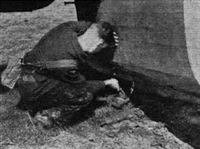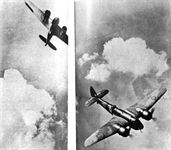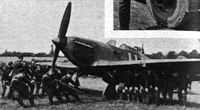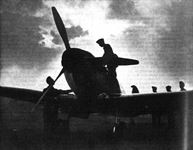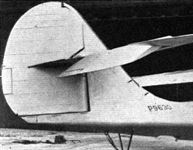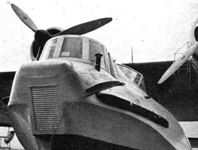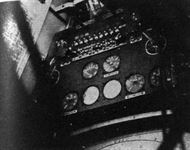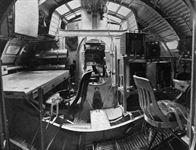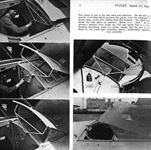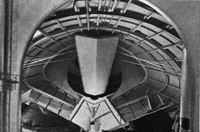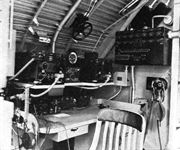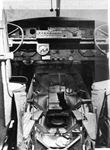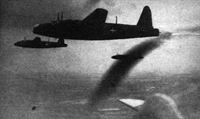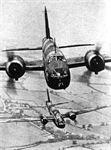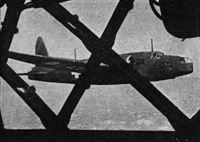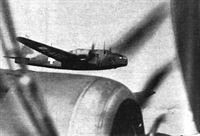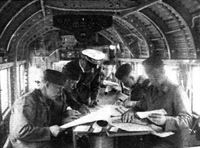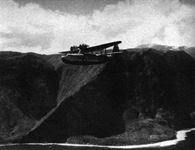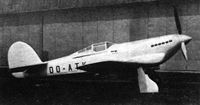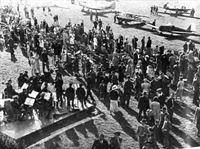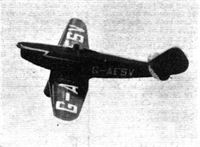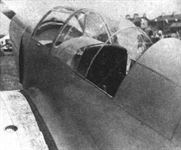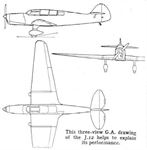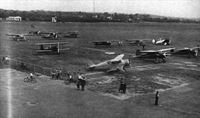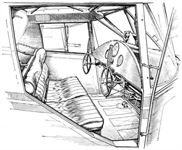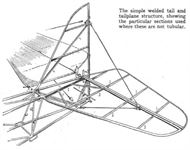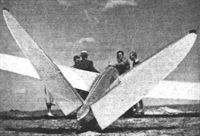Фотографии
-
Mud: Pedicures for the Blenheim and the sergeant
Самолёты на фотографии: Bristol Blenheim - Великобритания - 1936
-
Blenheim fighters were used extensively. One of these machines is seen attacking a raiding Blenheim over the Thames Estuary.
Самолёты на фотографии: Bristol Blenheim - Великобритания - 1936
-
A Blenheim fighter takes off at dawn watched by attendants of a Hurricane.
Самолёты на фотографии: Bristol Blenheim - Великобритания - 1936Hawker Hurricane - Великобритания - 1935
-
Регистрационный номер: G-ADSW Three Redhill V.R. Fairey Battles with the Sabena Douglas D.C.3 and the good Imperial “E” class ship Eddystone making the foreground.
Самолёты на фотографии: Armstrong Whitworth Ensign / A.W.27 - Великобритания - 1938Douglas DC-3 / C-47 Skytrain/С-53 Skytrooper / Dakota - США - 1935Fairey Battle - Великобритания - 1936
-
Manhattan skyline: One of the Transcontinental and Western Air Douglas D.S.T.s, or Sleeper Transports, flying over the Normandie, with the skyscraper forest of New York in the background and Brooklyn Bridge in the distance on the right.
A pair of Art Deco classics depart New York City - A TWA DC-3 flies over the French ocean liner SS Normandie, which made 139 westbound transatlantic voyages between 1935 and 1941.Самолёты на фотографии: Douglas DC-3 / C-47 Skytrain/С-53 Skytrooper / Dakota - США - 1935
-
An American Airlines D.C.3 over Niagara, with the American falls on the left and the real Niagara on the right.
Самолёты на фотографии: Douglas DC-3 / C-47 Skytrain/С-53 Skytrooper / Dakota - США - 1935
-
FOUR BLADED V.P.: One of the first pictures of the new Curtiss four-bladed variable-pitch airscrew. It is shown installed on the Twin Wasp engine of a Curtiss P-36A pursuit machine. This installation is of particular interest in view the fact that increasingly powerful engines are being installed in fighters, and airscrew ground clearance is becoming a big problem.
Самолёты на фотографии: Curtiss Hawk 75 / P-36 / Mohawk - США - 1935
-
A NEW GERMAN BOMBER: A revised version of the Heinkel He.111 bomber is in service with the Luftwaffe as shown in these views secured during the recent German exercises. It has a shorter, roomier nose and an external lower gun position or observation post. The engines can be Daimler Benz D.601s or Junkers Ju.211s.
Самолёты на фотографии: Heinkel He-111P/H - Германия - 1938
-
Самолёты на фотографии: Heinkel He-111P/H - Германия - 1938
-
"Rearming" a Hurricane, just returned from an interception, before the pilot has stopped his engines.
Самолёты на фотографии: Hawker Hurricane - Великобритания - 1935
-
All Set: A Hurricane (with v.p. airscrew) with pilot donning his brolly, starter ready, and flaps depressed for take-off.
Самолёты на фотографии: Hawker Hurricane - Великобритания - 1935
-
Mud: The de-bogging of a Hurricane.
Самолёты на фотографии: Hawker Hurricane - Великобритания - 1935
-
PATAGONIAN EXPRESS: The ubiquitous Junkers Ju.52 in South America. One of Aeropostale Argentina’s machines at Buenos Aires before leaving on its long, distance run to Rio Grande in Tierra del Fuego.
Самолёты на фотографии: Junkers Ju.52/3m - Германия - 1931
-
FROM A BALCONY IN BRUSSELS: A view of some of the French exhibits at the Brussels Show. In the foreground is the multi-purpose Potez 63, and behind it the single-seater Bloch 151. The external observation car on the Potez is just visible.
Самолёты на фотографии: Bloch MB.150/151/152/155C1 - Франция - 1937Potez Potez 63 - Франция - 1936
-
DEFENCE: A Spitfire preparing for a dawn patrol is typical of our preparations. In 1918 we finally repulsed the raiders of London, and we are far stronger now.
Самолёты на фотографии: Supermarine Spitfire - Великобритания - 1936
-
"Спитфайры" стартуют во время больших учений. Через две недели начнется Вторая мировая война...
Defending Spitfires show how their take-off has improved since the fitting of v.p. airscrews.Самолёты на фотографии: Supermarine Spitfire - Великобритания - 1936
-
Fiat B.R. 20 bomber (Italy).
Самолёты на фотографии: FIAT BR.20 Cicogna - Италия - 1936
-
Регистрационный номер: NC19452 THE LATEST BEECH: Various changes are noticeable in the new 18S Beechcraft which has 450 h.p. Wasp Junior engines and constant-speed airscrews. The design of the tail has been modified to provide an even better single-engined performance as far as piloting is concerned, but the most interesting feature of the Wasp Junior-engined Beech is the design of the cowlings with a smooth contour which not only reduces resistance, but also gives an even flow over the upper surface the wing. No air is discharged above, the cooling being regulated by means of flaps on the lower half of the cowling.
Самолёты на фотографии: Beechcraft Model 18 / C-45 Expeditor - США - 1937
-
Регистрационный номер: P9630 [15] The characteristic features of the Consolidated 28-5 large wing area, retractable wing-tip floats and peculiar hull formation - are apparent in the view.
Самолёты на фотографии: Consolidated PBY Catalina - США - 1935
-
Регистрационный номер: P9630 [15] Close-up of the float retracted and partially extended
Самолёты на фотографии: Consolidated PBY Catalina - США - 1935
-
Регистрационный номер: P9630 [15] A study of the tail with its single fin and very large rudder, the former built integral with the hull.
Самолёты на фотографии: Consolidated PBY Catalina - США - 1935
-
Регистрационный номер: P9630 [15] A view which shows more details of the tail, the broad hull and the termination of the step.
Самолёты на фотографии: Consolidated PBY Catalina - США - 1935
-
Регистрационный номер: P9630 [15] A view looking aft showing the superstructure in which the flight engineer is housed. A section of the deicer is also visible.
Самолёты на фотографии: Consolidated PBY Catalina - США - 1935
-
Регистрационный номер: P9630 [15] A view of the bows showing the location of the bomb aimer’s window and the gun turret.
Самолёты на фотографии: Consolidated PBY Catalina - США - 1935
-
Регистрационный номер: P9630 [15] A view of the installation of one of the Pratt and Whitney Twin Wasps with part of the cowling removed
Самолёты на фотографии: Consolidated PBY Catalina - США - 1935
-
Регистрационный номер: P9630 [15] The majority of the engine instruments are grouped on the flight engineer’s panel shown here and not in the pilot’s cockpit.
Самолёты на фотографии: Consolidated PBY Catalina - США - 1935
-
Регистрационный номер: P9630 [15] A unique view showing the compartment occupied by the navigator and the wireless operator. The Bendix installation seen on the right. The cylinders by the navigator’s table are drinking-water tanks.
Самолёты на фотографии: Consolidated PBY Catalina - США - 1935
-
Регистрационный номер: P9630 [15] Five views of one of the two deck gun positions. On the left the portion of decking which protects the gunner from the airstream is shown being raised after having been slid forward. The third view shows the side plates in position. On the right is a “shot” of the gunner’s position from inside the hull and below that is a view showing everything ready for action, except that the gun is nor fitted to the track-type mounting which, incidentally, operates very smoothly.
Самолёты на фотографии: Consolidated PBY Catalina - США - 1935
-
Регистрационный номер: P9630 [15] This is what the Americans call the tunnel gun position. Actually it is not so much a tunnel as an aperture in the floor which is normally filled by the folding section of hull seen above it. This view also shows the section and construction of the rear portion of the hull.
Самолёты на фотографии: Consolidated PBY Catalina - США - 1935
-
Регистрационный номер: P9630 [15] Main and auxiliary transmitters, two complete receivers, a direction-finder and an inter-communication system which extends throughout the hull and permits both pilots to use the wireless directly when necessary. The loop aerial is extended through the roof and is remotely controlled from the wheel seen in the smaller over the wireless operator’s table.
Самолёты на фотографии: Consolidated PBY Catalina - США - 1935
-
Регистрационный номер: P9630 [15] The pilot’s throttle and trim controls in the roof of the cockpit.
Самолёты на фотографии: Consolidated PBY Catalina - США - 1935
-
Регистрационный номер: P9630 [15] The oxygen mask as used by the crew of the Consolidated 28-5 leaves the mouth free to use the intercommunication system which extends throughout the boat.
Самолёты на фотографии: Consolidated PBY Catalina - США - 1935
-
Регистрационный номер: P9630 [15] A look into the cockpit of P9630. The front gunner/bomb aimer's position in the extreme nose is also visible.
The row of switches on the pilot’s dashboard transmit orders to corresponding visual indicators on the engineer’s panel. The flight engineer sits in the superstructure between the hull and the wing where he may observe the engines directly. He also operates the wing tip floats either manually or electrically.Самолёты на фотографии: Consolidated PBY Catalina - США - 1935
-
The answer: An infantry post has asked for information, the Lysander has picked up the message, and is now dropping the reply (seen just behind the tail.)
Самолёты на фотографии: Westland Lysander - Великобритания - 1936
-
Westland Lysanders of No. 4 Squadron among the clouds. The latter make a fine picture, but normally reconaissance machines like a clear view below.
Самолёты на фотографии: Westland Lysander - Великобритания - 1936
-
The Lysanders dive down to deal with some enemy position on the ground.
Самолёты на фотографии: Westland Lysander - Великобритания - 1936
-
The stuff to give the troops. Filling parachute canisters with machine gun rounds which will be dropped on an infantry post which is running short.
Самолёты на фотографии: Westland Lysander - Великобритания - 1936
-
Officers of No. 4 Squadron. Note the mixture of Army and Air Force uniforms. Among the former can be distinguished the Royal Tank Corps and the Royal Scots. All the pilots in Army squadrons are officers.
Самолёты на фотографии: Westland Lysander - Великобритания - 1936
-
Wheeling a Lysander out of the hangar.
Самолёты на фотографии: Westland Lysander - Великобритания - 1936
-
Регистрационный номер: D-AMHC FW 200A "Нордмарк" (борт D-AMHC) авиакомпании "Люфтганза". Август 1938 г.
Самолёты на фотографии: Focke-Wulf FW.200 Condor - Германия - 1937
-
The Miles Magister does some low altitude aerobatic and crazy flying - with a Reigate A.F.S. tender in the foreground.
Самолёты на фотографии: Miles Magister / M.14 - Великобритания - 1937
-
Регистрационный номер: D-ASND IN SERVICE: The first Junkers Ju.90 to be seen in this country arrived on the normal Berlin-London run on August 1. The impressive size of this forty-seater is shown by the relative smallness of the Marcel Bloch on the right. The “accident” on the left is merely a group of Imperial machines, including two Frobisher-class and one Ensign-class liner. The Ju.90’s tail unit is interestingly complicated.
Самолёты на фотографии: Armstrong Whitworth Ensign / A.W.27 - Великобритания - 1938Bloch MB.220 - Франция - 1936De Havilland Albatross / D.H.91 - Великобритания - 1937Junkers Ju.90 - Германия - 1937
-
Регистрационный номер: CF-ANU, CF-AXB IN SUMMER GUISE: A Fairchild and Bellanca of Dominion Skyways at Semmeterre. In Canada, of course, floats are used in the summer for operations off the beaten track; they are replaced by skis in the winter.
Самолёты на фотографии: Bellanca Pacemaker / Skyrocket - США - 1928Fairchild Model 82 - США - 1935
-
CANADIAN TERMINUS: Sea Island Airport, Vancouver, B.C., with one of Trans-Canada Air Lines' Lockheed Fourteens and one of United Air Lines’ old Boeing 247 Ds on the tarmac.
Самолёты на фотографии: Boeing Model 247 - США - 1933Lockheed Super Electra 14 - США - 1937
-
FLEET FIGHTER: A study of the Blackburn Roc two-seater fleet fighter (Bristol Perseus) as now being delivered to the Fleet Air Arm. It has a multi-gun Boulton Paul turret.
Самолёты на фотографии: Blackburn Roc / B-25 - Великобритания - 1938
-
Cant Z.501 reconnaissance flying-boat (Italy).
Самолёты на фотографии: CANT Z.501 Gabbiano - Италия - 1934
-
Fiat C.R.42 single-seater fighter (Italy).
Самолёты на фотографии: FIAT CR.42 Falco - Италия - 1938
-
FIRST FROM CHESTER: This perfectly normal Wellington is of special interest because it was assembled and delivered to the Service only eight months after work had been started on the building of the new Vickers-Armstrong works at Broughton, Chester.
Самолёты на фотографии: Vickers Wellington / Type 271 - Великобритания - 1936
-
Самолёты на фотографии: Vickers Wellington / Type 271 - Великобритания - 1936
-
Самолёты на фотографии: Vickers Wellington / Type 271 - Великобритания - 1936
-
Самолёты на фотографии: Vickers Wellington / Type 271 - Великобритания - 1936
-
As the sun sets the night-bombing Wellingtons are dragged from their hangars.
Самолёты на фотографии: Vickers Wellington / Type 271 - Великобритания - 1936
-
A "friendly" Wellington as seen through the geodesics of a consort. The white cross was the distinguishing mark.
Самолёты на фотографии: Vickers Wellington / Type 271 - Великобритания - 1936
-
A "friendly" Wellington slips low over East Anglia. These non-combatant machines were included for their "nuisance value."
Самолёты на фотографии: Vickers Wellington / Type 271 - Великобритания - 1936
-
Регистрационный номер: L4370 Another intimate glimpse of a “friendly” Wellington over the nacelle.
Самолёты на фотографии: Vickers Wellington / Type 271 - Великобритания - 1936
-
WHAT THE SECOND PILOT SEES from the corner of his eye. A unusual study of the pilot of a “friendly” Wellington, secured at some thousands of feet over the North Sea during the Air Exercise.
Самолёты на фотографии: Vickers Wellington / Type 271 - Великобритания - 1936
-
Savoia-Marchetti S.M. 85 dive-bomber (Italy).
Самолёты на фотографии: Savoia-Marchetti / SIAI SM.85 - Италия - 1936
-
NASAL ARCHITECTURE: A fine aerial study ol the nose of a Douglas B18-A bomber (two Wright Cyclones) of the U.S. Army Air Corps. A machine gun is installed in the spherical mounting below the projecting "transparency" which houses the bomb aimer The bomb traps in the belly of the fuselage are also visible. This type of Douglas is used extensively by America, but even with the two-speed supercharged Cyclones it is believed to be inferior in performance to the Whitley V or Wellington I - which is understandable, as the American type is quite an old adaptation of the DC-2 transport.
Самолёты на фотографии: Douglas B-18 Bolo - США - 1935
-
The crew of a Heinkel He 59 twin-engined floatplane, which is fitted with two B.M.W. VI engines
Самолёты на фотографии: Heinkel He-59 - Германия - 1931
-
Heinkel He 60 two-seater reconnaissance machines practising formation work over the Baltic
Самолёты на фотографии: Heinkel He-60 - Германия - 1931
-
Servicing a flight of Heinkel He 60s at Kiel-Holtenau. This type has a B.M.W. VI engine.
Самолёты на фотографии: Heinkel He-60 - Германия - 1931
-
Navigation instruction in the cabin of a Junkers Ju 52 seaplane which is used as a "flying classroom."
Самолёты на фотографии: Junkers Ju.52/3mW (See) - Германия - 1933
-
Inter-Island Airways, the transport company linking the Sandwich group, use Sikorsky S.43 amphibians, one of which is seen flying over the coastline of Hawaii. The apparently bare and gloomy rock is, in fact, a mass of vegetation.
Самолёты на фотографии: Sikorsky S-43 Baby Clipper/JRS/Y1OA-8 - США - 1936
-
Самолёты на фотографии: Blackburn Skua / B-24 - Великобритания - 1937
-
Регистрационный номер: L2874, L2889 COASTAL PATROL: Two flights of Blackburn Skua fleet fighter dive-bombers (Bristol Perseus XIII sleeve-valve engine) make an attractive picture off the South Coast.
Самолёты на фотографии: Blackburn Skua / B-24 - Великобритания - 1937
-
Регистрационный номер: L2883 The action of the Skua's "diving brake" flaps is illustrated here.
Самолёты на фотографии: Blackburn Skua / B-24 - Великобритания - 1937
-
View of the installation in the Skua I of the Bristol Perseus XII nine-cylinder sleeve-valve radial.
Самолёты на фотографии: Blackburn Skua / B-24 - Великобритания - 1937
-
The two pipes seen above the spinner feed air to the oil cooler.
Самолёты на фотографии: Blackburn Skua / B-24 - Великобритания - 1937
-
Регистрационный номер: L2867 This 3/4-rear view of the Skua I shows to advantage the unorthodox tail unit and the gunner’s position with its folding hood.
Самолёты на фотографии: Blackburn Skua / B-24 - Великобритания - 1937
-
An eloquent line-up of Skuas outside the Blackburn works at Brough.
Самолёты на фотографии: Blackburn Skua / B-24 - Великобритания - 1937
-
A NAVAL FIGHTER DIVE-BOMBER. Large numbers of Blackburn Skua I naval fighter dive-bombers, fitted with the Bristol Perseus XII nine-cylinder sleeve-valve engine, have already been delivered to units of the Fleet Air Arm. It has lately become permissible to disclose many of the unusually interesting features of the Skua, the majority of which are revealed in this specially prepared Flight drawing. The Skua has special flaps which not only improve the take-off and steepen the glide, but limit the diving speed to 220 knots.
Самолёты на фотографии: Blackburn Skua / B-24 - Великобритания - 1937
-
The unorthodox tail unit, of the Skua I. It will be noted that there is a balance flap above the rudder trimming tab.
Самолёты на фотографии: Blackburn Skua / B-24 - Великобритания - 1937
-
A detail view of one of the unusual flaps on the Skua which not only improve take-off and landing but act as diving brakes.
Самолёты на фотографии: Blackburn Skua / B-24 - Великобритания - 1937
-
An outer wing panel for the Skua minus its aileron and the majority of its skin covering. The location of the special flap is apparent.
Самолёты на фотографии: Blackburn Skua / B-24 - Великобритания - 1937
-
General arrangement of the Blackburn Skua I fighter dive-bomber (Bristol Perseus XII engine).
Самолёты на фотографии: Blackburn Skua / B-24 - Великобритания - 1937
-
In this photograph, the place where the automatically inflated dinghy has burst out of its housing in the wing can be seen.
Самолёты на фотографии: Fairey Swordfish - Великобритания - 1934
-
Регистрационный номер: L7075 FOR F.A.A. RE-EQUIPMENT: The new Fairey Albacore biplane for the Fleet Air Arm, showing the flaps depressed. It has a Bristol Taurus fourteen-cylinder sleeve-valve engine and can be used for dive-bombing, torpedo-dropping, spotting or reconnaissance.
Самолёты на фотографии: Fairey Albacore - Великобритания - 1938
-
Регистрационный номер: L7074 [2] OUR NEW T.S.R.: View of the Fairey Albacore torpedo-spotter-reconnoissance biplane which is now in production for the Fleet Air Arm. The engine is a fourteen-cylinder two-row Bristol Taurus sleeve-valve unit driving a Rotol three-bladed variable-pitch airscrew. It win be noted that the pilot has a fine view for deck landing.
Самолёты на фотографии: Fairey Albacore - Великобритания - 1938
-
Регистрационный номер: L7074 [2] Самолёты на фотографии: Fairey Albacore - Великобритания - 1938
-
Регистрационный номер: N7212 RUMBLING IN: A Lockheed Hudson reconnaissance bomber (two Wright Cyclones) coming in to land with Fowler flaps lowered. The machine illustrated, apparently, is not fitted with the standardised "letter-box" slots.
Самолёты на фотографии: Lockheed Hudson A-28 / A-29 - США - 1938
-
An admiring crowd is seen surrounding the Bombay.
Самолёты на фотографии: Bristol Bombay / Type 130 - Великобритания - 1935
-
TROOP TRANSPORT TRIAL: Several bomber transports were recently used to carry troops from Bembridge, I.O.W., to Yatesbury. A contingent is seen deplaning from a Bombay.
Самолёты на фотографии: Bristol Bombay / Type 130 - Великобритания - 1935
-
Самолёты на фотографии: Bristol Bombay / Type 130 - Великобритания - 1935
-
Showing how a spare engine is loaded into the capacious fuselage of the Bombay when the machine is used as a freighter.
Самолёты на фотографии: Bristol Bombay / Type 130 - Великобритания - 1935
-
The nose of the production-type Bombay differs considerably from that of the prototype. This view shows the new bomb-aimers' position and the installation of the Bristol Pegasus XXII engines which drive Rotol airscrews.
Самолёты на фотографии: Bristol Bombay / Type 130 - Великобритания - 1935
-
Регистрационный номер: L5808 This view gives an excellent idea of the size and appearance of the production type Bristol Bombay as built by the Short and Harland concern at Belfast.
Самолёты на фотографии: Bristol Bombay / Type 130 - Великобритания - 1935
-
The business-like pilot’s cockpit of the Bombay.
Самолёты на фотографии: Bristol Bombay / Type 130 - Великобритания - 1935
-
From left to right these interior views of the Bombay show the stretchers installed when the machine is employed on ambulance duties; the special bearers which permit the transport of spare engines; and the auxiliary fuel tanks which permit a range of 2,500 miles.
Самолёты на фотографии: Bristol Bombay / Type 130 - Великобритания - 1935
-
Самолёты на фотографии: Bristol Bombay / Type 130 - Великобритания - 1935
-
Самолёты на фотографии: De Havilland Dragon Rapide / Dominie / D.H.89 - Великобритания - 1934
-
Регистрационный номер: ZK-AGT, NZ558, ZK-AHS IN NEW ZEALAND: One of Cook Strait Airways’ D.H. Rapides flying on the west coast route between Nelson and Greymouth. The company uses five of these machines and also runs a service between Nelson, Blenheim and Wellington. An additional service from Nelson to Takaka is to be opened in October.
Самолёты на фотографии: De Havilland Dragon Rapide / Dominie / D.H.89 - Великобритания - 1934
-
Регистрационный номер: G-AFRG, K6933 NEW OVERLOAD: Two Harrow bombers, one outside and the other inside the hangar, which are used at Haltie’s Camp, Newfoundland, for the air refuelling of the Short boats used on the British Atlantic mail service. Only one is actually needed, but the second has been shipped over for use in case of emergency or minor accident. For Caribou's initial return crossing the refuelling equipment was not used, as a following wind and good conditions meant that the machine would reach not only Foynes, but also Southampton, without the necessity for topping up.
Самолёты на фотографии: Handley Page Harrow / H.P.54 - Великобритания - 1936
-
Регистрационный номер: G-AFCU, G-AFRL В июле 1939 года, еще до начала полетов между Саутгемптоном и Монреалем, в районе Саутгемптона отрабатывались дозаправки от самолета Handley Page Harrow.
PREPARING FOR THE FIRST: A photograph taken last week at Southampton showing Cabot receiving fuel from a Harrow tanker. Last week-end saw Caribou, commanded by Capt. J. C. Kelly Rogers, with Capt. S. G. Long as chief officer and Mr. B. C. Frost as first officer, make her first regular Atlantic crossing after being refuelled at Foynes. The machine, carrying 1,055 lb. of mail, reached Newfoundland at 10.10 p.m. (G.M.T.) on Saturday and was due to leave New York, on the return flight, yesterday. Cabot will make the next eastward crossing on Saturday.Самолёты на фотографии: Handley Page Harrow / H.P.54 - Великобритания - 1936Short Empire / S.23 - Великобритания - 1936
-
Регистрационный номер: OO-ATK The Belgian Renard R.38 single-seater fighter, fitted with a Rolls-Royce Merlin III. It is about to undergo flight tests and a top speed of nearly 340 m.p.h. is expected.
Самолёты на фотографии: Renard R.36 / R.37 - Бельгия - 1937
-
A view from the control tower of a small section of the large crowd at Wilmington last Saturday. In the background can be seen a B.F.W. M-35, Tipsy, Wicko and the new Parnall Trainer.
Самолёты на фотографии: Foster Wikner Wicko - Великобритания - 1936Messerschmitt BFW M.35 - Германия - 1933Parnall Model 382 / Heck III - Великобритания - 1939Tipsy B / BC - Бельгия - 1937
-
Регистрационный номер: G-AFSV [3] Самолёты на фотографии: Chilton D.W.1 - Великобритания - 1937
-
Регистрационный номер: G-AFSV [3] As the starter’s flag falls, the Train-engined Chilton starts off in the final tor the Folkestone Trophy race. Piloted by the Hon. A. W. H. Dalrymple, the Chilton won at 126 m.p.h.
Самолёты на фотографии: Chilton D.W.1 - Великобритания - 1937
-
Регистрационный номер: G-AFSV [3] The clean and “pretty” lines of the new Chilton are well shown in this picture - taken against a Savernake Forest background
Самолёты на фотографии: Chilton D.W.1 - Великобритания - 1937
-
Регистрационный номер: G-ADWG In the foreground are the handicappers and starters of the Folkestone Trophy race - Messrs. Dancy and Rowarth. The machine in the foreground, the Tiger Moth piloted by R. M. Hackney, finished second.
Самолёты на фотографии: De Havilland Tiger Moth / D.H.82 - Великобритания - 1931
-
A notable photograph - necessarily rather hazy by reason of the high telescopic magnification - showing H.E. shells bursting near a Queen Bee operating from the range visited by the author.
Самолёты на фотографии: De Havilland Queen Bee / D.H.82B - Великобритания - 1935
-
A Queen Bee on the catapult ready for launching.
Самолёты на фотографии: De Havilland Queen Bee / D.H.82B - Великобритания - 1935
-
With one wing down, but speedily to be corrected by the radio control, the Queen Bee leaves the catapult
Самолёты на фотографии: De Havilland Queen Bee / D.H.82B - Великобритания - 1935
-
Регистрационный номер: G-AFPC [2] Самолёты на фотографии: De Havilland Moth Minor / D.H.94 - Великобритания - 1937
-
Регистрационный номер: G-AFPC [2] An unusual view of the Minor, showing its distinctive plan form.
Самолёты на фотографии: De Havilland Moth Minor / D.H.94 - Великобритания - 1937
-
The air-brake usefully steepens the approach, but is not too effective for ab initio training purposes.
Самолёты на фотографии: De Havilland Moth Minor / D.H.94 - Великобритания - 1937
-
The control and instrument layout of the Moth Minor as equipped for blind-flying training. Notice that in this case the pupil takes the rear seat while the instructor is in charge of all incidental controls.
Самолёты на фотографии: De Havilland Moth Minor / D.H.94 - Великобритания - 1937
-
Регистрационный номер: G-AFUE [2] SEASONAL SCENE: The Jersey and Guernsey Airways’ D.H. Flamingo flying over Portelet Bay on the south coast of Jersey. This 95 is actually the prototype, which is in semi-experimental use by the two companies pending the arrival of further examples for the 1940 season.
Самолёты на фотографии: De Havilland Flamingo / D.H.95 - Великобритания - 1938
-
Регистрационный номер: G-AFUE [2] TEMPORARY EQUIPMENT: The prototype D.H.95 on the tarmac at Guernsey airport. This machine will shortly be replaced by a production type, three of which have been ordered by Jersey Airways.
Самолёты на фотографии: De Havilland Flamingo / D.H.95 - Великобритания - 1938
-
“SPORTS TOURERS” FOR THE SERVICE: For communication and liaison work, the Royal Air Force is taking delivery of a number of Percival Vega Gulls (D.H. Gipsy Six II). The machines are generally similar to their civil prototype though it will be noted that the windscreen is now more streamlined.
Самолёты на фотографии: Percival Vega Gull / K.1 - Великобритания - 1935
-
Регистрационный номер: G-AFCV BACK FROM AMERICA: Caribou, one of the two strengthened "C" class boats being used for the Atlantic mail services, taxies up to its berth at Southampton after the first two-way crossing. On the left is the monitor Erebus, in for a refit before going to South Africa.
Самолёты на фотографии: Short Empire / S.23 - Великобритания - 1936
-
On tow: A Power Boat taking one of the Short "C" class boats to its moorings in Rose Bay, Sydney.
Самолёты на фотографии: Short Empire / S.23 - Великобритания - 1936
-
Регистрационный номер: G-ADNO Within a few yards of starting, Geoffrey De Havilland accelerates past the line of spectators with the tail of the T.K.2 well up.
Самолёты на фотографии: De Havilland Technical School T.K.2 - Великобритания - 1935
-
Mr G. N. Wickner, in his Wicko, zooms up over some of the visiting aircraft, during the course of a demonstration flight.
Самолёты на фотографии: Foster Wikner Wicko - Великобритания - 1936
-
One of many remarkable photographs taken of the Messerschmitt Taifun.
Самолёты на фотографии: Messerschmitt Bf.108 Taifun - Германия - 1934
-
A glimpse of the D.L.H. "Offices" at Bathurst from the control cabin of one of the Blohm and Voss Ha.139 floatplanes used for Atlantic crossings.
Самолёты на фотографии: Blohm und Voss Ha.139 - Германия - 1936
-
Регистрационный номер: D-ADFJ ANGLE 2: Due to the perspective it is difficult to reconcile this view of the Ju.90 with that shown above. It shows among other things, the Junkers so-called “double-wing” arrangement.
Самолёты на фотографии: Junkers Ju.90 - Германия - 1937
-
Piaggio P-32 bomber (Italy).
Самолёты на фотографии: Piaggio P.32 - Италия - 1936
-
The transparent enclosure arrangement on the J.12. The rear portion slides and can be left in any position, while that over the front seat lifts. There is a wide luggage locker behind the rear seat.
Самолёты на фотографии: Irbitis, VEF I-11 / I-12 / I-17 - Латвия - 1936
-
Регистрационный номер: YL-ABS The clean lines of the V.E.F. are obvious in this photograph, taken during the Isle of Man races. The ailerons do not, as they appear, extend from centre section to wing tip - the inner portions are slotted flaps.
Самолёты на фотографии: Irbitis, VEF I-11 / I-12 / I-17 - Латвия - 1936
-
This three-view G.A. drawing of the J.12 helps to explain its performance.
Самолёты на фотографии: Irbitis, VEF I-11 / I-12 / I-17 - Латвия - 1936
-
A previous president of the New England Intercollegiate Flying Clubs, Bill Atterbury, presents the bomb-dropping trophy to one Flynn.
Самолёты на фотографии: WACO C / S Series - США - 1931
-
The scene at New Haven airport, the centre of the proceedings. This airport is on the edge of Long Island Sound and the airport manager hired machines to the entrants
Самолёты на фотографии: WACO C / S Series - США - 1931
-
SPOT LANDING: Allen Daily, of Yale, flying a Kitty Hawk (Waco F), wins the forced landing event. The mark, a white cross, is just below the undercarriage.
Самолёты на фотографии: WACO F / A Series / PT-14 - США - 1930
-
Регистрационный номер: D-EXIV Fraulein Vera von Bissing makes her point (or appears to do so) when chatting with two German companions in the shade of her B.F.W. M-35.
Самолёты на фотографии: Messerschmitt BFW M.35 - Германия - 1933
-
Регистрационный номер: S1655 WHERE THE BAFFINS WENT: A considerable number of ex-R.A.F. Blackburn Baffin torpedo-bombers are being used by the Royal New Zealand Air Force. Those above are flying over mountains in the Wellington Province.
Самолёты на фотографии: Blackburn Baffin / B-5 - Великобритания - 1933
-
THE BIG BOEING DEVELOPED: A view of the latest version of the four-engined Boeing bomber, which is known as the B-17. Compared with the ordinary B-17 it has a revised nose and engine nacelles and its Wright Cyclone engines drive turbo superchargers. The type is in production for the U.S. Army Air Corps.
Самолёты на фотографии: Boeing B-17 Flying Fortress - США - 1935
-
Самолёты на фотографии: Boeing B-17 Flying Fortress - США - 1935
-
Регистрационный номер: G-AFVU The Taylorcraft at its test and demonstration base - Ratcliffe, Sir Lindsay Everard’s private aerodrome - with the control tower in the background.
Самолёты на фотографии: Taylorcraft A / B / C / F-19 / F-21 / F-22 - США - 1937
-
A good idea of the layout and comparative spaciousness of the two-seater cabin is obtainable from this drawing. Luggage is carried behind the squab. The neatness of the control and instrument layout is particularly noteworthy.
Самолёты на фотографии: Taylorcraft A / B / C / F-19 / F-21 / F-22 - США - 1937
-
A separate trimmong surface is used in the Taylorcraft; this can be seen, in "gliding" position, below the tailplane. Notice the inspection zips and the lifting handle on the right.
Самолёты на фотографии: Taylorcraft A / B / C / F-19 / F-21 / F-22 - США - 1937
-
The simple welded tail and tailplane structure, showing the particular sections used where these are not tubular.
Самолёты на фотографии: Taylorcraft A / B / C / F-19 / F-21 / F-22 - США - 1937
-
Sqn. Ldr. Shaw brings the Grunau Baby in after looping down from 1,000 ft.- the cloud height.
Самолёты на фотографии: Schneider Grunau Baby - Германия - 1931
-
Регистрационный номер: G-ACGX Самолёты на фотографии: De Havilland Moth Major / D.H.60GIII - Великобритания - 1932
-
An artist’s somewhat impressionistic idea of how the Asboth helicopter will appear in flight.
Самолёты на фотографии: Asboth helicopter - Австрия - 1935
-
A retractable tricycle undercarriage is one of the features of the Asboth A.H.X. The 39 ft. dia. rotor blades are set rigidly at an angle corresponding to the resultant between lift and centrifugal force, and have no flapping hinges.
Самолёты на фотографии: Asboth helicopter - Австрия - 1935
-
The front elevation of the A.H.X on the left shows the faired beam which carries the controlling surfaces and houses the retracted undercarriage. From the plan view (above) it will be seen that the rotor blades are of relatively low aspect ratio.
Самолёты на фотографии: Asboth helicopter - Австрия - 1935
-
FAST AND FAR: The French Amiot 370 (two special Hispano Suiza 12Y engines) in which M. Rosse, on an unsuccessful attempt to break the world’s speed record for 10,000 km. and the record for distance in a closed circuit (now held by Japan), averaged more than 186 m.p.h. for 3,728 miles. The Japanese record is 115.5 m.p.h. for about 6,876 miles. The Amiot took off at a weight of 22,217. It is generally similar to a type of bomber now in production for l’Armee de l’Air.
Самолёты на фотографии: Amiot Amiot 370 - Франция - 1937
-
PRIVATE FLYING, CIRCA 1910: There may or may not be lessons for present-day light aeroplane designers in this special Bleriot built for M. Deutsch de la Meurthe with the enclosed cabin, the open-air, brougham-esque position of the driver (his column can just be seen) and the forward elevator. It did actually fly, air resistance notwithstanding, on a very doubtful 100 h.p.
Самолёты на фотографии: Bleriot Bleriot-XXIV Aeronef - Франция - 1911
-
ORIGINAL EMPENNAGE: The tail of Lt. Stanley's sailplane Nomad, which broke the American altitude record (and a wing) at the recent Elmira meet. The movable surfaces act, through a differential mechanism, both as elevators and rudders.
Самолёты на фотографии: Stanley Nomad - США - 1938
-
An early Asboth helicopter was the A.H.4 seen here. It was flown on more than one occasion by Capt. R. N. Liptrot of the British Air Ministry.
Самолёты на фотографии: Asboth AH-4 - Австрия - 1930
Статьи
- Flight
- Flight Advertisements
